
 Data Structure
Data Structure Networking
Networking RDBMS
RDBMS Operating System
Operating System Java
Java MS Excel
MS Excel iOS
iOS HTML
HTML CSS
CSS Android
Android Python
Python C Programming
C Programming C++
C++ C#
C# MongoDB
MongoDB MySQL
MySQL Javascript
Javascript PHP
PHP
- Selected Reading
- UPSC IAS Exams Notes
- Developer's Best Practices
- Questions and Answers
- Effective Resume Writing
- HR Interview Questions
- Computer Glossary
- Who is Who
Understanding the Interpretations of Histograms
In this article we will learn about histograms and we will see detailed view about histogram and its various types. We will also draw see implementation using python.
Histogram
Histogram provides us visual representation of data, it is used to shows bar chart for numerical data. We can visualize the different distributions and patterns in the dataset. X-axis in the histogram is used to denote the range of values and the y-axis is used to denote the frequency or count of data points.
Applications of Histogram
1. Analysis of Data Distribution
We use histogram to analyze the data distribution and get insight about shape, size, skewness and tendency of data. Using these factors, we can get clear characteristics of data which can be used to make good decision.
2. Image Processing
We use Histogram in the image processing for various purpose like contrast enhancement, thresholding and image equalization. Histogram technique is used to improve the contrast and enhance the visual appearance of the image. We can analyze the threshold using pixel intensities.
3. Process Monitoring For Quality Control
Histogram plays very crucial role in quality control and process monitoring. In the manufacturing company we use histograms to monitor process parameters and ensure product quality. We manipulate temperature, pressure and deviation using histogram which helps in quickly adjustment of these things for maintaining quality standards.
4. Statistical Analysis
histogram is used to explore the data distribution. We use histogram to validate assumption we made for statistical tests, assess normality, and identify data pattern which may affect the statistical models of selected data. can also check in case it is following any specific statistical distribution which can be helpful to analyzing the distribution.
Interpretations of Histogram
Regular Histogram
This type of histogram gives us straightforward visualization of data. This is used to show the frequency of data within each interval.
Example
import matplotlib.pyplot as plt
import numpy as np
data = np.random.randn(1000)
plt.hist(data, bins=30, edgecolor='red')
plt.title('Regular Histogram')
plt.xlabel('Data')
plt.ylabel('Frequency')
plt.show()
Output
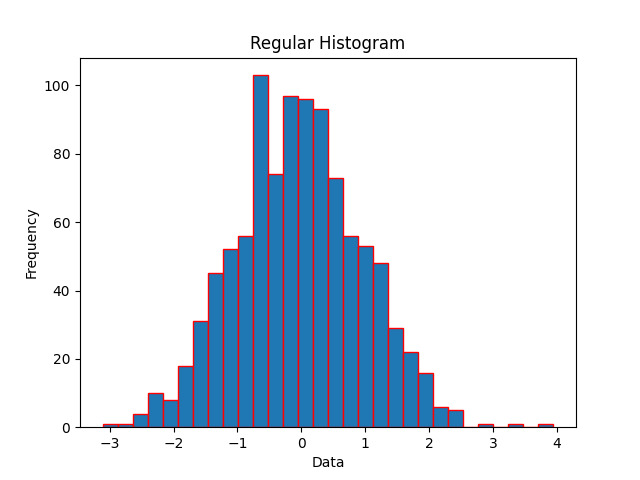
Normalized Histogram
This type of histogram is also called as probability histogram. This is used to show the frequency and related frequency of data in every interval.
Example
import matplotlib.pyplot as plt
import numpy as np
data = np.random.randn(500)
plt.hist(data, bins=20, density=True, edgecolor='black')
plt.title('Regular Histogram')
plt.xlabel('Data')
plt.ylabel('Frequency')
plt.show()
Output
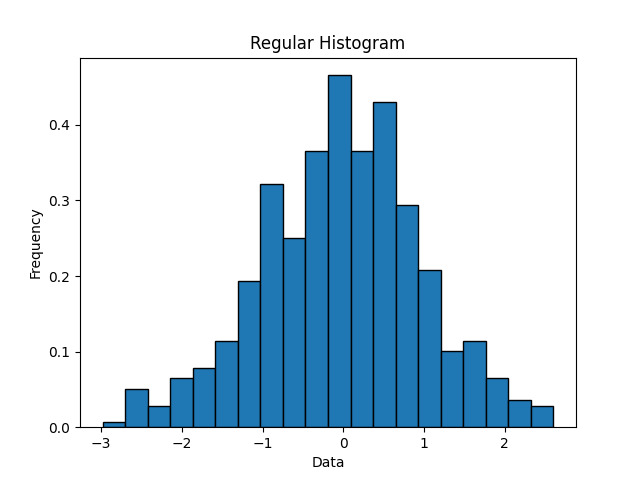
Stacked Histogram
Stacked histogram is used to compare distributions of multiple groups and categories in the dataset. This histogram provide us very useful for visualizing the dataset.
Example
import matplotlib.pyplot as plt
import numpy as np
ds1 = np.random.randn(500)
ds2 = np.random.randn(500)
plt.hist([ds1, ds2], bins=30, stacked=True, edgecolor='black')
plt.title('Stacked Histogram')
plt.xlabel('Data')
plt.ylabel('Frequency')
plt.legend(['Group 1', 'Group 2'])
plt.show()
Output
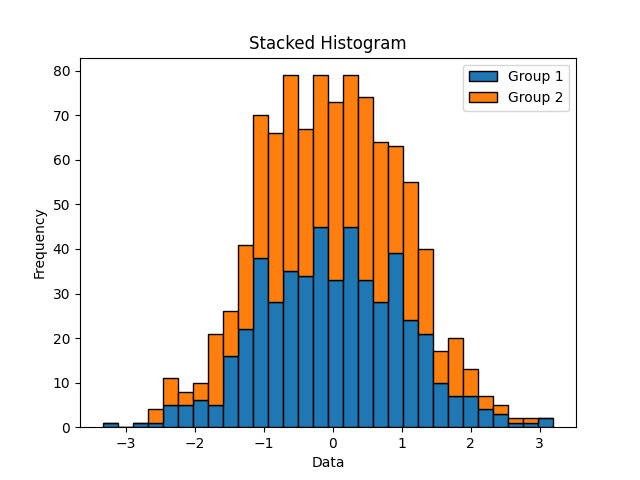
2D Histogram
We use 2D histogram to represent the joint distribution of two variables. We first divide the data into rectangular binds and color each of the bins based on the frequency. The 2D histogram is also called Heatmap.
Example
import numpy as np
import matplotlib.pyplot as plt
x = np.random.randn(1000)
y = np.random.randn(1000)
plt.hist2d(x, y, bins=30, cmap='Blues')
plt.title('2D Histogram')
plt.xlabel('X')
plt.ylabel('Y')
plt.colorbar(label='Frequency')
plt.show()
Output
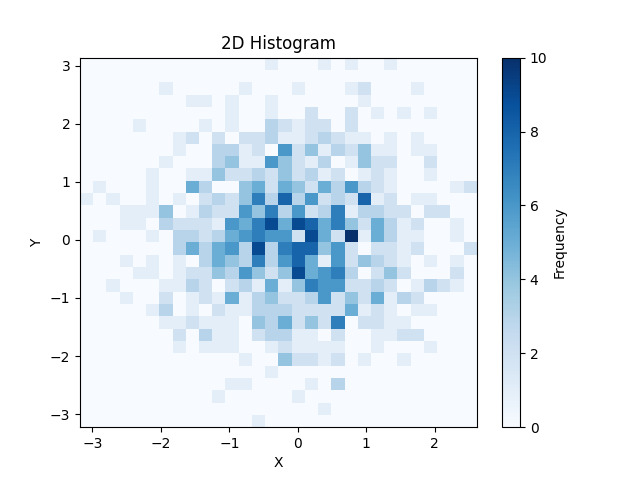
Cumulative Histogram
This histogram is used to visualize the cumulative frequency or cumulative probability distribution of data. It gives us details of data distribution at different thresholds. This histogram shows how data accumulates as we move from left to right on the x-axis.
Example
import matplotlib.pyplot as plt
import numpy as np
data = np.random.randn(500)
plt.hist(data, bins=30, cumulative=True, density=True, edgecolor='black')
plt.title('Cumulative Histogram')
plt.xlabel('Data')
plt.ylabel('Cumulative Probability')
plt.show()
Output
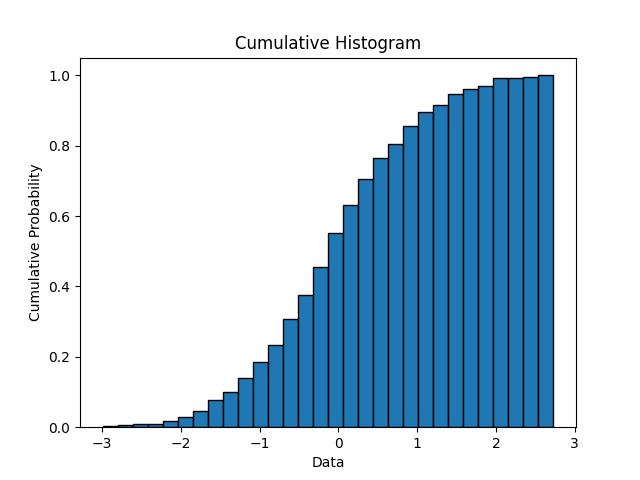
Clustered Histogram
A clustered histogram is used to display separate histograms of different groups and categories. We can use this histogram to company the different histogram directly.
Example
import matplotlib.pyplot as plt
import numpy as np
ds1 = np.random.randn(500)
ds2 = np.random.randn(500)
plt.hist(ds1, bins=30, alpha=0.7, label='Group 1', edgecolor='black')
plt.title('Clustered Histogram')
plt.hist(ds2, bins=30, alpha=0.7, label='Group 2', edgecolor='black')
plt.xlabel('Data')
plt.ylabel('Freq')
plt.legend()
plt.show()
Output
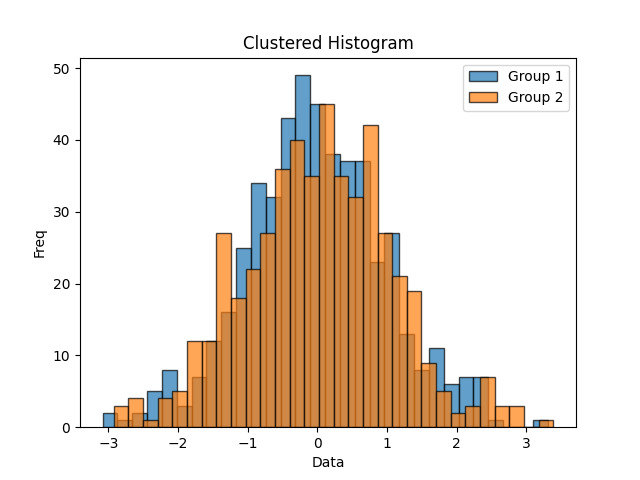
Conclusion
In conclusion we can say that histogram provides us various ways to visualize the graph and explore the patterns in the dataset. We can use many types of histogram like regular histograms, normalized histograms, stacked histograms,clustered histograms, cumulative histograms to analyze the data. In the python language we have Matplotlib library using which we can create histogram and get details of our data distribution.

